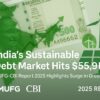S&P Global unveiled the India Forward report and presented key insights. Edited excerpts:

DK Joshi: India’s positive growth is a surprise despite several risks. One reason is government investment in infrastructure. Mid and large corporates have good balance sheets with low debt. Country has huge reserves which helps manage external shocks much better. We expect $7.2 trillion economy by 2030. There are 2 key challenges. First is getting private corporate investment going. Despite competitive tax regime and govt push, private investment is growing slowly, which calls for addressing domestic uncertainties. Second, India’s monetary policy is dependent upon food inflation, which has partly to do with climate. Forex reserved are a kind of insurance for the economy.
India is a net importer and runs a trade deficit. Asian economies are very competitive in manufacturing exports, but India is strong in services. Logistics is one key factor in boosting exports. World environment was more receptive to exports earlier, but not now and in the near future. Efficiency contribution of growth is a push. Labor productivity increase is a challenge. So capital is the main driver.
Geeta Chugh: India is getting included in various global indices. India’s sovereign debt has doubled. Credit growth will slow due to pressure on deposits. SLR may reduce. Indian bank’s burden to support government is very high.
Atul Arya: International Energy Agency published a roadmap to net zero by 2050. BMW has very little steel content in the car in value terms and hence they are paying a premium for green steel. Hydrogen today costs $5 per kg but it needs to come down to $1-2 per kg range.
Deepa Kumar: How India manages geopolitical risk is border driven. But the next level is along the Indian Ocean stretching from South East Asia to Middle East to Africa. Economic growth requires coastline to be leveraged. Wars in the neighborhood point to India’s risks. 42% of India’s crude oil comes through the Strait of Hormuz. Two frameworks are key indicators for exports. One is PLI kind of schemes. The other is free trade agreements. We came out of RCEP but 24 bilateral FTA are in pipeline.
Rahul Kapoor: India benefited from supply chain diversification. None of India’s port is in top 20. India has lost market-share to Colombo. India is a big importer of coal. India has over dependence on railways to move coal, and now there a shift to coastal ships. India is playing catchup with China and Vietnam.
Pulkit Agarwal: India is very sensitive to the price of oil. Price has been favorable in last 2 years. Lots of wars going on in terms of military and tariffs – but thankfully oil not impacted. Non-OPEC supplies oil are huge. China used to be 50% of oil demand growth earlier and now India is leading. Prices of commodities like steel, plastics, aluminium, etc, are falling, especially those coming from China.
Rajeev Lala: Last decade has been a sentiment push in energy transformation. However India is not giving up on any fuel including coal, oil, gas, etc. India is not villanizing any fuel type. India’s issue is import dependency – our import dependence on gas is rising.
Gauri Jawhar: Key factors are affordability, sustainability and security of energy. India targeting net zero by 2070. Fossil fuel will still remain 70% in 2030. We are trying to triple our renewable capacity, but it will not happen by 2030. Solarization of petrol pumps is example of new business models. We need to exhaust the energy efficiency option to reach net zero. Fossil fuel companies still delver better stock market sector than non-fossil companies. LNG deal with UAE gives 2.5% benefit.
India’s goal is energy independency by 2047. One is green hydrogen, of which export is a big component. Thought India is a net importer of crude, we are exporter of petrol, diesel, etc. We are attractive to friend shoring. India is a big center for GCC. Clean energy is linked to supply chain shifts.
Puneet Gupta: Energy transition is incomplete without mobility. While CNG is in great demand, around 2027 we see a plateau as battery prices come down.
Pushan Sharma: Agri accounts for 50% of employment. 85% of sown area is in field crops and only 15% for fruits, etc. We need improvement in productivity of field crops. We need to increase the realization for farmers to encourage them to continue in agri.
Recent Articles:
Tide’s Formula: Less Pain, More Gain

New Leaders, New Strategies, New Frontiers








